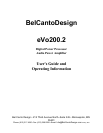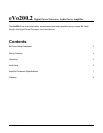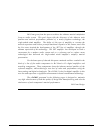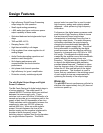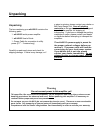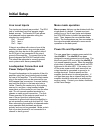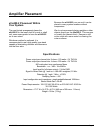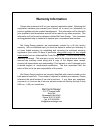
eVo200.2 Owner's Manual Page 4
Design Features
• High efficiency Digital Power Processing
output stage for cool operation
• Small signal analog processing
• > 800 watts short term continuous power
output capability in Mono mode
• Optimized balanced and single-ended input
stage
• THD and IMD <0.01%
• Damping Factor >100
• High thermal stability in all stages
• Fully regulated, low noise supplies for all
analog stages
• Audio Grade decoupling capacitors and
resistors used throughout
• Soft clipping performance with
uncompromised low level distortion
performance
• Anti-phase dual channel operation.
• High efficiency for ‘green’ amplification
• Protection circuitry outside signal path
The eVo Digital Output Stage and Digital
Power Processor
The Bel Canto Design eVo digital output stage is
of unique simplicity. The output uses 2 N
channel MOSFET switches which are switched
between the power supply rails. These
switches turn on and off within 30 billionths of a
second and provide an on resistance path to the
supply of less than 65 thousandths of an ohm.
These switches switch alternately between the
supplies at a rate over 600,000 cycles per
second (600 kHz). When no audio signal is
present, the ratio between the time at the
positive supply and the negative is balanced to
provide no audio frequency output. The
switching stage is isolated from the loudspeaker
by a single Inductor/Capacitor. This 80kHz
second order low pass filter is used to reject
high frequency energy and optimize phase
response – while preserving high frequency
information.
Furthermore, the digital power processor adds
small levels of high frequency dither to insure
that an inherently linear output stage
characteristic is maintained from very low to
very high output levels. The audio frequency
information modulates the output stage by
changing the time relationship between the
positive and negative supply rails. The critical
timing information is controlled by the digital
power processor and the effective switching
frequency is changed over a 200 kHz to 1500
kHz range. This spreads the digital energy
created by the amplifier over a wide bandwidth,
greatly reducing the energy at any one
frequency. This permits using a simple LC filter
to remove the digital energy and maintains
excellent phase response. Feedback is taken
from the common node of the output switches
before the LC filter and fed back to the digital
power processor. This feedback is used to
insure that any variations in the switching speed
of each output device are compensated for,
optimizing the linearity of the output stage.
Warm-Up
The eVo200.2’s sonic performance will start to
stabilize after approximately forty (40) hours of
continuous power up.



